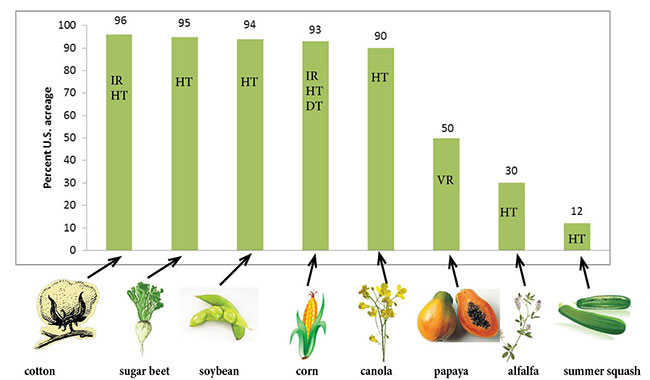by P. Byrne* (8/14)
Quick Facts…
- Genetic modification (GM) technology allows the transfer of genes for specific traits between species using laboratory techniques.
- GM crops were first introduced in the U.S. in the mid-1990s. Most current GM crops grown in the U.S. are engineered for insect resistance or herbicide tolerance. Corn, soybeans, and cotton are the three largest acreage GM crops.
- GM crops grown in Colorado include corn, alfalfa, sugar beet, soybeans, and canola.
- Potential future applications of the technology include nutritional enhancements, stress tolerance, disease resistance, biofuel efficiency, and remediation of polluted sites.
- GM crops are regulated at the federal level by the U.S. Department of Agriculture (USDA), the Environmental Protection Agency (EPA) and the Food and Drug Administration (FDA), each with authority to oversee specific aspects of the crops and their products.
Since GM crops were introduced in the U.S. in the mid-1990s, they have become widely adopted by growers of several largeacreage field crops. This fact sheet explains the technology for developing GM crops and describes GM crops currently on the market in the U.S.
What are GM crops?
The term genetically modified (GM), as it is commonly used, refers to the transfer of genes between organisms using a series of laboratory techniques for cloning genes, splicing DNA segments together, and inserting genes into cells. Collectively, these techniques are known as recombinant DNA technology. Other terms used for GM plants or foods derived from them are genetically modified organism (GMO), genetically engineered (GE), bioengineered, and transgenic. ‘Genetically modified’ is an imprecise term and a potentially confusing one, in that virtually everything we eat has been modified genetically through domestication from wild species and many generations of selection by humans for desirable traits. The term is used here because it is the one most widely used to indicate the use of recombinant DNA technology. According to USDA standards for organic agriculture, seeds or other substances derived through GM technology are not allowed in organic production.
Which GM crops are currently grown in the U.S.?
Although in the U.S. genetically engineered versions of 19 plant species have been approved, only eight GM crop species are grown commercially (Figure 1). Because several of them are major crops, the area planted to GM varieties is very large. Most current GM crops have been engineered for resistance to insects, tolerance to herbicides (weed control products) or both.

Figure 1. Currently grown GM crops in the U.S., traits for which they are modified, and percent of total acreage of the crop that is planted to GM varieties. IR=insect resistant, HT=herbicide tolerant, DT=drought tolerant, VR=virus resistant.
What traits have been modified in GM crops?
Insect-resistant crops contain genes from the soil bacterium Bacillus thuringiensis (Bt). The protein produced in the plant by the Bt gene is toxic to a targeted group of insects—for example European corn borer or corn rootworm—but not to mammals. The most common herbicide tolerant (HT) crops are known as Roundup Ready®, meaning they are tolerant to glyphosate (the active ingredient in Roundup® herbicide). Glyphosate inactivates a key enzyme involved in amino acid synthesis that is present in all green plants; therefore, it is an effective broad spectrum herbicide against nearly all weeds. Roundup Ready® crops have been engineered to produce a resistant form of the enzyme, so they remain healthy even after being sprayed with glyphosate. Some cultivars of corn and cotton are referred to as ‘stacked’, meaning they have transgenes for both insect resistance and HT. According to USDA-ERS (2013), over half of the U.S. corn and cotton acreage was planted to stacked cultivars in 2013.
Which GM crops are grown in Colorado?
Corn, alfalfa, and sugar beet are the major GM crops grown in Colorado, but smaller areas of soybeans and canola are also planted. The corn, alfalfa, and soybean crops are nearly all used as livestock feed. Sugar beet is used to extract and purify sugar, and canola is used mostly for edible oil. All GM seeds are targeted to commercial growers; no vegetable or fruit varieties for home production are GM.
What are potential GM crops of the future?
Some potential applications of GM crop technology are:
- Nutritional enhancement: Higher vitamin content; more healthful fatty acid profiles;
- Stress tolerance: Tolerance to high and low temperatures, salinity, and drought;
- Disease resistance: For example, orange trees resistant to citrus greening disease or American chestnut trees resistant to fungal blight;
- Biofuels: Plants with altered cell wall composition for more efficient conversion to ethanol;
- Phytoremediation: Plants that extract and concentrate contaminants like heavy metals from polluted sites.
How are GM crops regulated in the U.S.?
 |
 |
 |
Three U.S. government entities have authority to regulate GM crops: the United States Department of Agriculture (USDA), the Environmental Protection Agency (EPA), and the Food and Drug Administration (FDA). They do not, however, individually regulate all GM crops. For example, USDA is involved in approving the field release of most GM plants, but EPA is involved only in pest and pesticide resistance traits, and FDA only regulates crops destined for food, feed, or pharmaceuticals. Thus, EPA does not have authority to regulate a vitamin-enhanced tomato, and FDA would not regulate a drought tolerant turfgrass. These federal agencies review extensive information submitted by the crop developer, for example, the nature and stability of the transgene and its protein product, effects on non-target organisms in the field environment, composition of the food product, and potential for allergic reaction. If the agencies are satisfied that the proposed crop does not pose threats to the environment and does not increase risks for food or feed safety, the crop is determined to have nonregulated status, that is, it is approved for commercialization.
Are GM crops grown in other countries?
According to a recent report (James 2014), GM crops were grown in 26 other countries in 2013. The largest global acreage crops were soybean, corn, cotton, and canola, in that order. The U.S. has the greatest area of these crops, about 40% of the world total. Other large producers include Brazil, Argentina, India, and Canada.
Besides GM crops, are there other GM ingredients in our food supply?
No GM food animals have yet been approved in the U.S., although a GM salmon engineered for rapid growth is under review. GM microorganisms are used to produce rennin for production of cheese and GM yeast has been approved for winemaking .
| For more information on GM crops, see the following CSU fact sheets:
Bt Corn: Health and Environment, Fact Sheet No. 0.707 Managing Corn Pests with Bt Corn, Fact Sheet No. 0.708 Labeling of Genetically Engineered Foods, Fact Sheet No. 9.371 |
How does GM technology differ from other plant breeding techniques?
The era of scientific crop improvement dates back to around 1900, when the impact of Gregor Mendel’s studies on trait inheritance in peas became widely recognized. Since then, a broad range of techniques has been developed to improve crop yields, quality, and resistance to disease, insects, and environmental stress. Most plant breeding programs rely on manual cross-pollination between genetically distinct plants to create new combinations of genes. The progeny plants are intensively evaluated over several generations and the best ones are selected for potential release as new varieties. An example is a tomato variety that is selected for disease resistance and tolerance to cool temperatures. Other techniques included within the conventional plant breeding toolbox are development of hybrid varieties by crossing two parental strains to produce offspring with increased vigor; and induced mutations to create useful variation. GM technology is much more precise in that it transfers only the desired gene or genes to the recipient plant. Another branch of agricultural biotechnology—distinct from GM technology—involves selecting plants for DNA patterns known to be associated with favorable traits such as higher yield or disease resistance.
The shared DNA code
Most organisms store their genetic information in the form of DNA molecules in chromosomes. The sequence of chemical bases in a DNA strand encodes a specific order of amino acids, which are the building blocks of proteins. Proteins carry out many functions in cells and tissues, which together are responsible for an organism’s characteristics. Because most life forms share this same language of heredity—and due to scientific advances in molecular biology—it is now possible to transfer a gene from one species to another, for example from a bacterium to a plant, and have it function in its new host.
What is inserted into a GM plant?
The inserted DNA fragment contains one or a few genes, which contain the DNA sequence information encoding specific proteins, along with DNA segments that regulate production of the proteins. The inserted fragment also sometimes contains a marker gene to easily identify plants that have incorporated the transferred genes, also known as transgenes, into their chromosomes.
How are transgenes inserted?
There are two principal methods for transgene insertion:
Gene gun: In this method, microscopic pellets of gold or tungsten are coated with the transgene fragment and shot at high velocity into plant cells or tissues. In a small proportion of cases, the pellet will pass through the cells and the DNA fragment will remain behind and become incorporated into a plant chromosome in the cell nucleus.
Agrobacterium tumefaciens: This method utilizes a biological vector, the soil dwelling bacterium Agrobacterium tumefaciens, which in nature transfers part of its DNA into plants and causes crown gall disease. Genetic engineers have taken advantage of this DNA transfer mechanism while disarming the disease-causing properties. Plant and bacterial cells are co-cultivated in a petri dish under conditions that facilitate gene transfer. This allows incorporation of genes in a more controlled manner than with the gene gun; however, it does not work equally well in all plant species.
How are whole plants obtained from plant cells or tissues?
Insertion of transgenes is generally an inefficient process, with only a few percent of plant cells or tissues successfully integrating the foreign gene. Various strategies are used to identify the small percentage of cells/tissues that have actually been transformed. The next step is to develop those cells or tissues into whole plants capable of producing seed. This is done through a process called tissue culture, that is, growing plants on agar or a similar medium in the presence of plant nutrients and hormones under controlled environmental conditions.
What happens next?
The crop developers then begin a long series of evaluations to determine that the gene has been incorporated successfully, that it is inherited in a stable and predictable manner, that the desired trait is expressed to the expected level, and that the plant does not show any negative effects. Evaluations are initially done in controlled greenhouses and growth chambers. Once sufficient seed is produced and the appropriate permission is received, experimental plants are grown in field trials. Field evaluations follow strict guidelines that include isolation from related plants to avoid cross-pollination, careful cleaning of planting and harvesting machinery, frequent monitoring of crop growth, and checking the field for two seasons after the trial for the presence of volunteer plants that have arisen from seed inadvertently left behind.
References
Council for Agricultural Science and Technology (CAST). 2014. The potential impacts of mandatory labeling for genetically engineered food in the United States. Issue Paper 54. CAST, Ames, Iowa. Available at https://www.cast-science.org/wp-content/uploads/2018/12/CAST_Issue_Paper_54_web_optimized_29B2AB16AD687.pdf
Federoff, N. 2004. Mendel in the Kitchen: A Scientist’s View of Genetically Modified Food. National Academies Press, Washington, D.C. Available at www.nap.edu/catalog.php?record_id=11000
James, C. 2014. ISAAA Brief 46-2013, Global Status of Commercialized Biotech/GM Crops: 2013. www.isaaa.org/resources/publications/briefs/46/default.asp
Kole, C., C.H. Michler, A.G. Abbott, and T.C. Hall. 2010. Transgenic Crop Plants. Vol. 1: Principles and Development. Springer-Verlag, Berlin, Heidelberg.
U.S. Department of Agriculture-Economic Research Service. 2013. Recent trends in GE adoption. https://www.ers.usda.gov/data-products/adoption-of-genetically-engineered-crops-in-the-u-s/recent-trends-in-ge-adoption/
*P. Byrne, Colorado State University, professor, soil and crop sciences. 8/14
Colorado State University, U.S. Department of Agriculture, and Colorado counties cooperating. CSU Extension programs are available to all without discrimination. No endorsement of products mentioned is intended nor is criticism implied of products not mentioned.
Go to top of this page.





